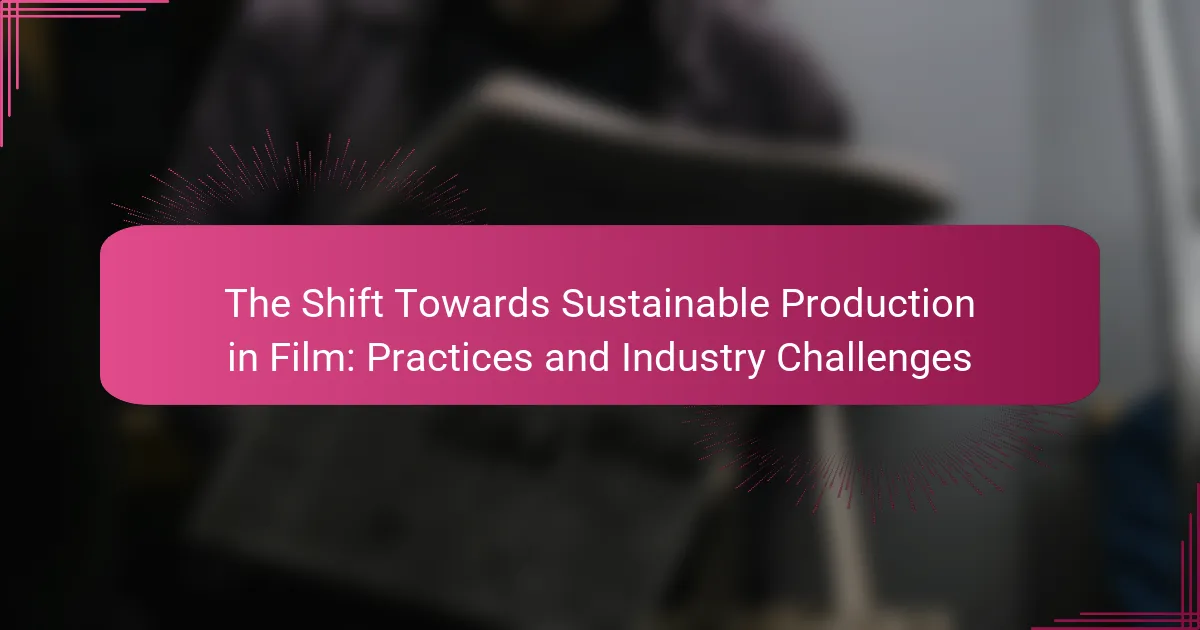The film industry is increasingly shifting towards sustainable production practices to minimize environmental impact. This movement encompasses strategies such as waste reduction, energy conservation, and the use of eco-friendly materials. Key examples include the adoption of renewable energy sources, energy-efficient lighting, and sustainable transportation for cast and crew. Organizations like the Producers Guild of America and the Green Production Guide are providing frameworks and resources to support this transition. Future trends indicate a greater reliance on renewable energy, digital technologies to cut paper waste, and enhanced waste management strategies. Overall, the industry’s commitment to sustainability is reshaping film production and responding to audience demand for environmentally responsible practices.

What is the Shift Towards Sustainable Production in Film?
The shift towards sustainable production in film refers to the industry’s movement to minimize its environmental impact. This includes adopting practices that reduce waste, conserve energy, and promote eco-friendly materials. Many film productions are now implementing green practices such as using renewable energy sources and sustainable transportation options. For example, the use of LED lighting has become more common due to its energy efficiency. Additionally, organizations like the Producers Guild of America have established guidelines for sustainable practices in filmmaking. This shift is driven by increasing awareness of climate change and the need for responsible resource management. The industry recognizes that sustainable production can also lead to cost savings and enhance brand reputation. Overall, the shift towards sustainability is reshaping how films are produced and consumed.
Why is sustainable production important in the film industry?
Sustainable production is important in the film industry because it reduces environmental impact. The film industry is known for high energy consumption and waste generation. Implementing sustainable practices minimizes carbon footprints associated with film production. For instance, using renewable energy sources can decrease reliance on fossil fuels. Additionally, sustainable production practices can lead to cost savings in the long term. According to a study by the British Film Institute, sustainable initiatives can reduce production costs by up to 30%. Furthermore, audiences increasingly prefer eco-friendly films, influencing box office success. Therefore, sustainable production not only benefits the environment but also enhances the industry’s economic viability.
What are the environmental impacts of traditional film production?
Traditional film production has significant environmental impacts. It generates substantial waste, including set materials and food waste. The use of energy-intensive equipment contributes to high carbon emissions. Transportation of cast and crew adds to the carbon footprint. Water usage for various production needs can strain local resources. Additionally, chemicals from film processing can contaminate water supplies. According to a report by the British Film Institute, the film industry contributes over 3 million tons of CO2 annually. This highlights the urgent need for sustainable practices in film production.
How does sustainable production benefit the film industry economically?
Sustainable production benefits the film industry economically by reducing operational costs and attracting investments. Implementing eco-friendly practices often leads to lower energy consumption. For example, using renewable energy sources can decrease utility expenses significantly. Additionally, sustainable practices can enhance a film’s marketability. Audiences increasingly prefer environmentally conscious productions, which can lead to higher ticket sales. Grants and tax incentives are often available for sustainable projects. This financial support can offset production costs further. Studies show that films adopting sustainable practices often report improved profitability. The overall economic impact is positive, fostering a more resilient film industry.
What practices are being adopted for sustainable film production?
Sustainable film production is adopting practices such as using renewable energy sources, minimizing waste, and implementing eco-friendly materials. Productions are increasingly utilizing solar and wind energy to power sets. Waste reduction strategies include recycling and composting on set. Many filmmakers are opting for digital over physical media to decrease material use. Eco-friendly materials are being used for set design and costumes. Green certifications are pursued to validate sustainability efforts. Industry guidelines, like the Green Production Guide, assist filmmakers in adopting these practices. These measures aim to reduce the carbon footprint of film productions significantly.
What are the key strategies for reducing carbon footprints in film production?
Key strategies for reducing carbon footprints in film production include using renewable energy sources, optimizing transportation, and minimizing waste. Implementing solar or wind energy can significantly lower emissions. Efficient transportation planning reduces fuel consumption and travel distances. Adopting digital technologies cuts down on physical materials. Sustainable set designs utilize recyclable or eco-friendly materials. Waste management practices, like composting and recycling, further decrease environmental impact. According to a report from the Green Production Guide, these practices can reduce a production’s carbon footprint by up to 30%.
How are filmmakers incorporating renewable energy sources?
Filmmakers are incorporating renewable energy sources by using solar panels and wind turbines on set. These methods reduce reliance on fossil fuels during production. Many film productions now utilize electric generators powered by renewable energy. For example, the 2020 film “The Green Knight” employed solar energy for its lighting needs. Additionally, filmmakers are opting for energy-efficient LED lighting, which consumes less power. Some productions also implement energy audits to assess and improve efficiency. The use of renewable energy aligns with industry sustainability goals. This shift reflects a growing commitment to environmental responsibility in filmmaking.
What challenges does the film industry face in implementing sustainable practices?
The film industry faces significant challenges in implementing sustainable practices. High production costs deter many filmmakers from adopting eco-friendly methods. Limited access to sustainable materials and technologies complicates the transition. Additionally, industry traditions often prioritize speed and efficiency over sustainability. The lack of standardized guidelines for sustainable practices creates confusion. Resistance from stakeholders accustomed to traditional methods hinders change. Furthermore, the transient nature of film projects makes long-term sustainability planning difficult. These challenges collectively impede the industry’s shift towards greener production methods.
What are the financial barriers to adopting sustainable production methods?
The financial barriers to adopting sustainable production methods include high initial investment costs and ongoing operational expenses. Sustainable technologies often require significant upfront capital for equipment and infrastructure. For instance, renewable energy systems can be expensive to install. Additionally, sustainable materials may have higher procurement costs compared to conventional options. Budget constraints in the film industry further limit the ability to invest in sustainable practices. Limited financial incentives or subsidies for green initiatives can also deter investment. According to a 2021 report by the International Energy Agency, transitioning to sustainable methods can lead to long-term savings but poses short-term financial challenges.
How do industry standards and regulations impact sustainable practices?
Industry standards and regulations significantly influence sustainable practices in film production. They establish guidelines that promote environmentally friendly methods. For instance, regulations may require the reduction of carbon emissions during filming. Compliance with these standards often leads to the adoption of renewable energy sources on set. Industry certifications encourage filmmakers to prioritize sustainability in their projects. The implementation of best practices is often driven by these regulatory frameworks. Research shows that adhering to sustainability standards can enhance a film’s marketability. Thus, industry standards and regulations serve as critical drivers for the adoption of sustainable practices in film production.

How is the film industry responding to the shift towards sustainability?
The film industry is increasingly adopting sustainable practices in response to the shift towards sustainability. Productions are implementing eco-friendly measures such as reducing waste, using renewable energy, and sourcing sustainable materials. For example, many film sets now utilize energy-efficient lighting and equipment to lower carbon footprints. Additionally, organizations like the Green Production Guide provide resources to help filmmakers adopt sustainable practices. A 2021 report from the British Film Institute indicated that 70% of UK productions are now taking steps to minimize their environmental impact. Furthermore, initiatives like the “Sustainable Production Certification” are being established to recognize and promote sustainable filmmaking efforts.
What initiatives have been launched to promote sustainability in film?
Numerous initiatives have been launched to promote sustainability in film. The Green Production Guide provides resources for filmmakers to adopt eco-friendly practices. The Sustainable Production Alliance focuses on industry-wide collaboration for sustainable filmmaking. The BAFTA Albert initiative offers training and tools for reducing carbon footprints in productions. The Film Industry Greenhouse Gas Protocol helps measure and manage emissions. Many film festivals now feature sustainability awards to encourage greener practices. Additionally, the American Film Institute has implemented sustainability guidelines for productions. These initiatives aim to reduce the environmental impact of film production significantly.
How are film festivals encouraging sustainable practices?
Film festivals are encouraging sustainable practices by implementing eco-friendly initiatives. Many festivals now prioritize waste reduction and recycling programs. They are adopting digital ticketing to minimize paper use. Some festivals partner with local organizations to promote sustainable transportation options. Additionally, they offer awards for films that highlight environmental themes. These efforts align with global sustainability goals and raise awareness among filmmakers and audiences. For instance, the Cannes Film Festival has introduced a sustainability charter to guide its operations. This charter includes commitments to reduce carbon footprints and promote biodiversity.
What role do industry organizations play in promoting sustainability?
Industry organizations play a crucial role in promoting sustainability within the film industry. They establish guidelines and best practices for sustainable production. These organizations often provide resources and training to help filmmakers adopt eco-friendly practices. They also advocate for policies that support sustainability at local, national, and international levels. By collaborating with stakeholders, they foster partnerships that enhance environmental responsibility. Industry organizations often conduct research to identify sustainable technologies and methods. They also recognize and reward sustainable practices through awards and certifications. This incentivizes filmmakers to prioritize sustainability in their projects.
What technologies are emerging to support sustainable film production?
Emerging technologies supporting sustainable film production include digital tools, renewable energy sources, and eco-friendly materials. Digital tools, such as cloud-based collaboration platforms, reduce the need for physical resources and travel. Renewable energy sources like solar and wind power are increasingly utilized on sets, minimizing carbon footprints. Eco-friendly materials, including biodegradable props and sustainable costumes, are becoming standard in production design. Additionally, virtual production technologies enable filmmakers to create immersive environments without extensive physical sets. These advancements collectively contribute to reducing the environmental impact of film production.
How are digital tools being utilized for sustainable planning and execution?
Digital tools are utilized for sustainable planning and execution by enhancing efficiency and reducing waste. Software applications streamline project management, enabling real-time tracking of resources and energy consumption. Data analytics tools assess environmental impact by measuring carbon footprints throughout production. Virtual production technologies minimize physical set construction, thereby conserving materials. Collaboration platforms facilitate communication, ensuring all team members adhere to sustainability goals. Additionally, simulation software allows for testing various scenarios to optimize resource usage. These advancements contribute to a more eco-friendly film production process.
What innovations in materials are contributing to greener production?
Biodegradable materials are significantly contributing to greener production in the film industry. These materials, such as polylactic acid (PLA) and polyhydroxyalkanoates (PHA), decompose naturally, reducing landfill waste. Innovations in plant-based plastics are also emerging, offering sustainable alternatives to traditional petroleum-based options. Recycled materials, like recycled polyethylene terephthalate (rPET), are being utilized to minimize resource consumption and energy use. Additionally, advancements in bio-based composites enhance material performance while lowering environmental impact. Research indicates that using these innovative materials can cut greenhouse gas emissions by up to 70%. These developments are essential for achieving sustainability goals in film production.

What future trends can we expect in sustainable film production?
Future trends in sustainable film production include increased use of renewable energy sources. Productions are expected to implement solar and wind energy to power sets. Eco-friendly materials will gain popularity for set design and costumes. The industry will likely adopt more digital technologies to reduce paper waste. Carbon offsetting initiatives will become standard practice for productions. Sustainable transportation options for cast and crew will be prioritized. Waste reduction strategies will focus on recycling and composting on set. Finally, audience demand for sustainability will drive studios to adopt greener practices.
How is audience demand influencing sustainable practices in film?
Audience demand is significantly influencing sustainable practices in film. Filmmakers are increasingly adopting eco-friendly methods to meet viewer expectations. A 2021 survey by the British Film Institute showed that 79% of audiences prefer films produced sustainably. This preference drives studios to implement green practices, such as reducing waste and using renewable energy. Notable examples include productions like “Avatar” and “The Lord of the Rings,” which prioritize environmental responsibility. Additionally, film festivals now emphasize sustainability, showcasing eco-conscious films. The growing awareness of climate change among audiences further propels this shift. As a result, sustainable practices are becoming essential for attracting viewers and ensuring box office success.
What are the potential long-term benefits of sustainability for the film industry?
Sustainability in the film industry can lead to significant long-term benefits. These benefits include cost savings, enhanced brand reputation, and reduced environmental impact. Sustainable practices can lower production costs by minimizing waste and energy consumption. For example, using renewable energy sources can reduce electricity expenses. A strong commitment to sustainability can attract environmentally conscious audiences. This can lead to increased ticket sales and viewer engagement. Additionally, sustainable production practices can enhance a studio’s reputation. This can foster partnerships with other eco-friendly brands. Reducing carbon footprints can also contribute to compliance with future regulations. As governments increasingly prioritize sustainability, proactive measures can mitigate risks associated with regulatory changes. Overall, the film industry stands to gain financially and socially from adopting sustainable practices.
What practical steps can filmmakers take towards sustainability?
Filmmakers can adopt several practical steps towards sustainability. They can utilize energy-efficient lighting and equipment to reduce power consumption. Implementing a digital workflow minimizes paper usage and waste. Filmmakers can also source local materials and talent to decrease transportation emissions. Using eco-friendly set designs and materials helps lessen environmental impact. Establishing a waste management plan ensures proper disposal and recycling of materials. Additionally, filmmakers can educate cast and crew on sustainable practices during production. Tracking carbon emissions can provide insights for future improvements. These steps contribute to a more sustainable film industry.
How can independent filmmakers implement sustainable practices on a budget?
Independent filmmakers can implement sustainable practices on a budget by prioritizing resource efficiency. They can use digital tools to reduce paper waste. Filmmakers can opt for energy-efficient lighting to lower electricity costs. Collaborating with local suppliers minimizes transportation emissions and costs. Utilizing recycled materials for set designs also saves money. Filmmakers can engage in community-based projects to build support networks. These practices not only cut costs but also contribute to environmental responsibility. Research indicates that sustainable filmmaking can reduce overall production costs by up to 30%.
What resources are available for filmmakers looking to adopt sustainable methods?
Filmmakers can access various resources to adopt sustainable methods. Organizations like the Green Production Guide provide guidelines for eco-friendly practices. The Sustainable Production Toolkit offers practical tools and checklists for filmmakers. Industry initiatives, such as the Producers Guild of America’s Green Production Initiative, promote sustainability. Additionally, workshops and seminars on sustainable filmmaking are available through film festivals. Online platforms also offer courses focused on green production techniques. These resources equip filmmakers with knowledge and strategies for reducing environmental impact.
The main entity of the article is sustainable production in the film industry. The article outlines the industry’s shift towards eco-friendly practices aimed at minimizing environmental impact, including waste reduction, energy conservation, and the use of renewable resources. It discusses the importance of sustainable production, the environmental impacts of traditional methods, and economic benefits such as cost savings and enhanced marketability. Additionally, the article highlights key strategies for reducing carbon footprints, the challenges faced in implementing sustainable practices, and the role of industry organizations and emerging technologies in promoting sustainability. It concludes with practical steps filmmakers can take to adopt sustainable methods and the resources available to support these initiatives.
